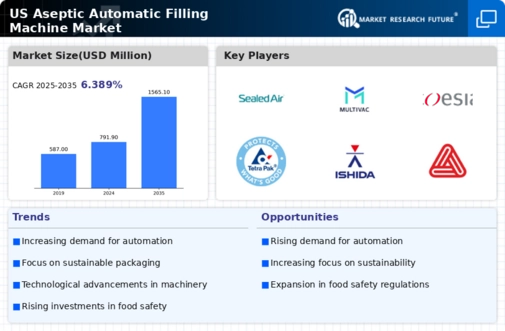Emerging Trends in E-commerce
The rise of e-commerce has transformed the retail landscape, impacting the aseptic automatic-filling-machine market. As online grocery shopping becomes increasingly prevalent, manufacturers are adapting their production processes to meet the demands of e-commerce. The convenience of home delivery necessitates the use of aseptic filling technologies to ensure product integrity during transportation. With e-commerce sales in the grocery sector projected to reach $100 billion by 2025, the need for efficient and reliable packaging solutions is paramount. This trend is likely to drive the adoption of aseptic automatic-filling machines, as companies strive to enhance their supply chain efficiency and meet consumer expectations.
Increased Focus on Food Safety
Food safety remains a paramount concern for consumers and regulatory bodies alike, significantly impacting the aseptic automatic-filling-machine market. With rising incidences of foodborne illnesses, manufacturers are compelled to adopt stringent safety measures. The implementation of aseptic filling technologies ensures that products are free from microbial contamination, thereby enhancing consumer trust. According to recent data, approximately 48 million people in the US experience foodborne illnesses annually, underscoring the critical need for safe food processing methods. This heightened focus on food safety is likely to drive investments in aseptic automatic-filling machines, as companies prioritize compliance with safety standards and consumer expectations.
Growth of the Beverage Industry
The beverage industry is witnessing substantial growth, which directly influences the aseptic automatic-filling-machine market. With the increasing consumption of ready-to-drink beverages, including juices, dairy products, and plant-based drinks, manufacturers are seeking efficient filling solutions. The US beverage market is projected to exceed $200 billion by 2027, creating a favorable environment for the adoption of aseptic filling technologies. These machines facilitate the production of shelf-stable beverages without the need for preservatives, aligning with consumer preferences for healthier options. As a result, the aseptic automatic-filling-machine market is poised to capitalize on this burgeoning sector.
Rising Demand for Packaged Foods
The aseptic automatic-filling-machine market experiences a notable surge in demand due to the increasing popularity of packaged foods. As consumers prioritize convenience and longer shelf life, manufacturers are compelled to adopt advanced filling technologies. The market for packaged foods in the US is projected to reach approximately $500 billion by 2026, indicating a robust growth trajectory. This trend necessitates the implementation of aseptic filling processes to ensure product safety and quality. Consequently, the aseptic automatic-filling-machine market is likely to benefit from this growing consumer preference, as manufacturers seek efficient solutions to meet the rising demand for safe and shelf-stable food products.
Technological Innovations in Automation
Technological advancements play a pivotal role in shaping the aseptic automatic-filling-machine market. Innovations such as artificial intelligence and machine learning are increasingly integrated into filling processes, enhancing efficiency and precision. These technologies enable manufacturers to optimize production lines, reduce waste, and improve overall operational performance. The market is expected to witness a compound annual growth rate (CAGR) of around 7% from 2025 to 2030, driven by these innovations. As companies strive to remain competitive, the adoption of state-of-the-art aseptic filling machines becomes essential, further propelling the growth of the aseptic automatic-filling-machine market.



















Leave a Comment